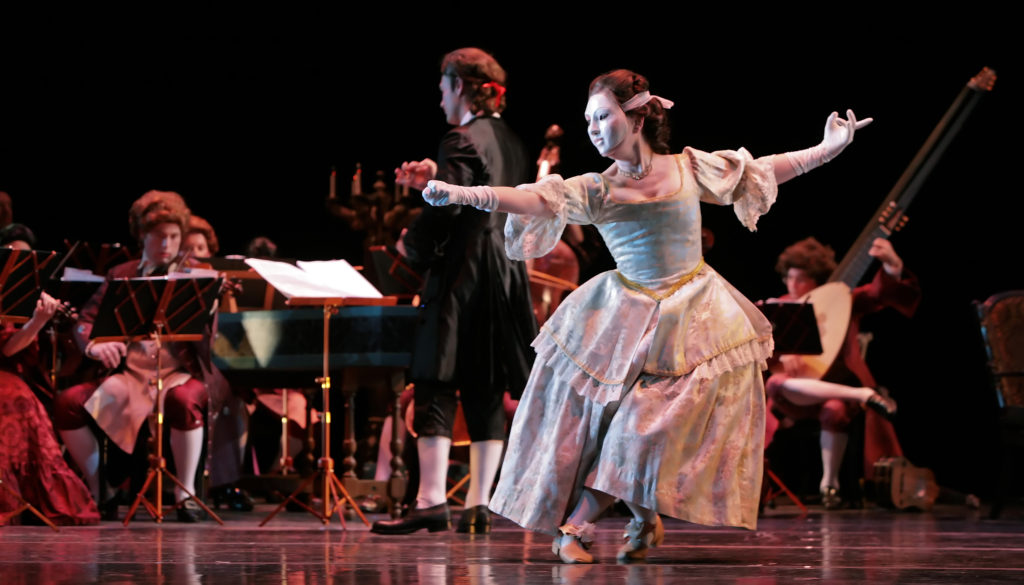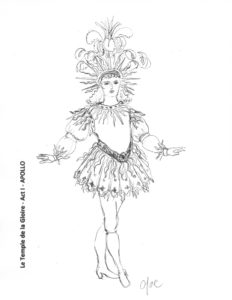 Dance has never been more political than it is today, with artists creating work on themes of feminism, racism, inequality, violence and the fight for justice. The issues may be topical, but dance as a political act goes back centuries. Take Jean-Philippe Rameau’s Baroque opera-ballet, The Temple of Glory (Le temple de la Gloire), performed for France’s King Louis XV in 1745 at the Palace of Versailles.
Dance has never been more political than it is today, with artists creating work on themes of feminism, racism, inequality, violence and the fight for justice. The issues may be topical, but dance as a political act goes back centuries. Take Jean-Philippe Rameau’s Baroque opera-ballet, The Temple of Glory (Le temple de la Gloire), performed for France’s King Louis XV in 1745 at the Palace of Versailles.
“Voltaire, who was the librettist, was trying to use the medium of opera and ballet to present an argument for different kinds of leaders,” says Catherine Turocy, artistic director of the New York Baroque Dance Company and one of the world’s foremost experts on the performing arts of the period. Though called a “ballet,” The Temple of Glory uses Baroque dance technique, which predates ballet as we think of it today – there are no tutus or pointe shoes in sight.
It’s also a rare purely political ballet – neither is there a prince, princess nor love story. “It was written in 1745, and one of the things in our own Constitution that people were fighting for was this idea of the pursuit of happiness,” Turocy explains. “Voltaire is making suggestions about how society could be better.”
The Temple of Glory, as it was first presented at Versailles, has not been seen since. But the long-lost original score was recently rediscovered at UC Berkeley, and the reconstructed work will be performed in April at Zellerbach Hall. Co-produced by the Philharmonia Baroque Orchestra and Chorale, Cal Performances and Centre de Musique Baroque de Versailles, the magnificent production features 30 dances choreographed by Turocy and musical performance by Nicholas McGegan and the Philharmonia Baroque. Turocy’s company dancers will be joined by Cal students and Bay Area professionals.
Baroque and other historical dance styles are not as far removed from today’s dance as they might seem. The parallels are many, from performative qualities to technical rigor to the conviction that the arts take us beyond our mere selves. In this interview, Turocy delves into the origins of The Temple of Glory and discusses Baroque’s relevance to modern dance and culture.

Claudia Bauer: Modern dancers and choreographers might be surprised at how relevant Baroque dance is to their work.
Catherine Turocy: I just got back from Cuba, where I had the opportunity of presenting the style to (former Royal Ballet star) Carlos Acosta’s new company, called Acosta Danza. I was curious to see how professional dancers who’d never seen this work before, what their reactions would be. I got this beautiful letter from him at the end. He says, “The joy with which our dancers have assumed your teaching will help us in our efforts to create a company that embraces the whole dance, without distinction of epochs and styles, in the search for a unique and beautiful result.”
CB: That must have been gratifying.
CT: A lot of times people ask me, Can professional dancers relate to this dance style today? And I think that the answer is yes. (Carlos) certainly sees a place for it, in terms of people studying it and understanding more about the resonating roots of historical dance that come through theatrical dance today, whether it’s ballet or modern dance. We also worked with the pantomime technique, which in a way relates both to modern and ballet.
CB: How does Baroque pantomime relate to modern dance?
CT: If you’re doing anything like Pina Bausch, or if you’re doing some of the older modern dances like The Moor’s Pavane, you take on a particular kind of dramatic, emotional character. So whenever you’re dealing with emotions and dramatic context, the kind of alphabet of gestures and postures, and the way the body moves from one extreme to another, is very delineated in the Baroque technique.
CB: Talk about the relevance of Da Vinci’s Vitruvian Man, and the body moving toward the heavens and the earth through dance. I hear artists reference this in terms of spiraling in the body, extending beyond your physical self, sending your energy out.
CT: The Vitruvian Man is the idea that the body is a microcosm of the cosmos. They had their understanding of their place in the world and their relationship to the world, and that was expressed in the arts through the body and the posturing. Man has this question that never goes away: Who am I? Why am I here? Where is my place? It was being answered through a shared aesthetic with all the arts.
CB: I’m thinking about how popular it is to create cross-genre collaborations, bringing musicians, artists and dancers together to commune, in a way, on a relevant social issue or cultural question.
CT: This was much more the expected way of examining different things, when you’re talking about 18th-century opera, like Le temple de la Gloire. This idea of the pursuit of happiness is in the final act, when King Trajan reaches the Temple of Glory. He’s crowned by Glory and he says, “Wait, this is not enough … I want to make this a world where one can have the freedom to pursue happiness.” It’s right out there.
CB: It’s painfully relevant at this moment in our history.
CT: Everyone has been saying that! (laughs) Trajan comes in with these five captive kings. He’s won the war, but instead of putting the kings in prison or degrading them, he lets them go. It’s the monarch who has a sense of humanity and compassion. He goes to an even further level. He says that the Temple of Happiness should be for every sex, every age and every station of life.
CB: Is “every sex” the actual translation from the French?
CT: Yes.
CB: That’s kind of amazing.
CT: Yes! In court life at that time, there was lots of cross-dressing. And Louis XIV’s brother (Philippe I, Duke of Orléans) was out of any kind of category.
CB: Non-binary.
CT: Yes.
CB: Is your choreography based on original notations?
CT: There’s two beautiful choreographies that were published, one in 1700 and one in 1704, in Paris, for Apollo. I thought I would use that as a basis of inspiration for the choreography for the first hero dance. There are no notations for the Muses, but there is some talk about the Dance of the Spheres, and there’s a lot of iconography with the Muses in (Tiepolo’s) wonderful ceiling paintings. I used the idea of the Muses from the period, and concepts of the patterning from the sphere to inform that dance. The second act is a little bit more exotic. Bacchus and his wife, Erigone, are the main singing characters; you’re going to see bacchantes and satyrs and some followers of Bacchus trying to win the Temple of Glory.
CB: Was the work meant as a message to Louis XV?
CT: There was a huge Battle of Fontenoy, that the French won. Louis XV was at the battle with his young son, the Duke of Noailles. It was in honor of winning this major international battle. The thing about the Muses that people forget is that they were the protectors of culture. If somebody is celebrating the end of a war, the Muses come out, because they’ve kept the arts and sciences going while this war and devastation is happening, and they celebrate the new peace.
CB: How was it received by the court?
CT: Apparently Louis XV wasn’t thrilled (laughs). Because Voltaire was telling him what kind of leader he should be. It was set up to take to the Paris Opera (in 1746), but Rameau, being in tune with what the public would buy, basically said to Voltaire, “We’ve got to rewrite this, because no one’s going to come to see a ballet without a love story.” So they rewrote Act I and Act III. I suppose people were thinking, “Okay, you’ve given us a political statement that’s tuned to what you want to say to the king, but we can’t possibly sell it.”
CB: People are really using performing art as a way to make political statements. I don’t think they realize that they’re within a long tradition of doing that.
CT: I think you’re absolutely correct. The court masque was definitely in politics, they weren’t just fun dances. Many of them had messages that were so far-reaching.
CB: Thank you, Catherine.
CT: Thank you.

